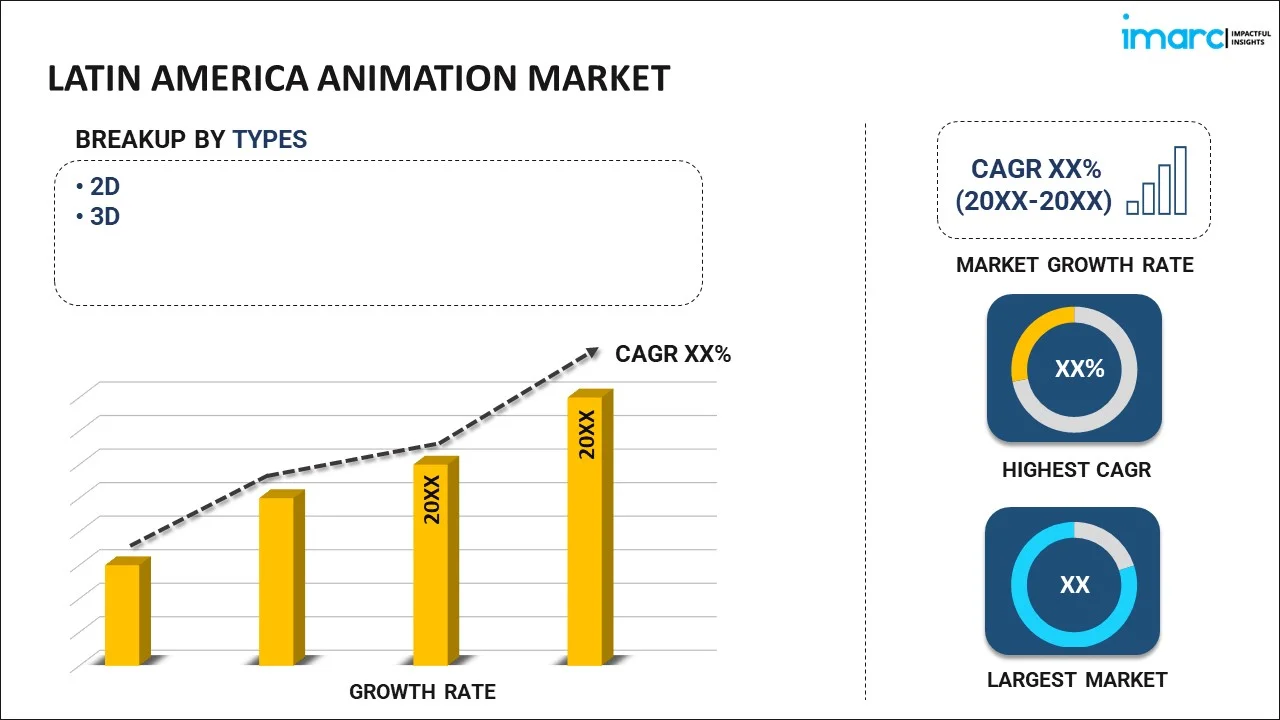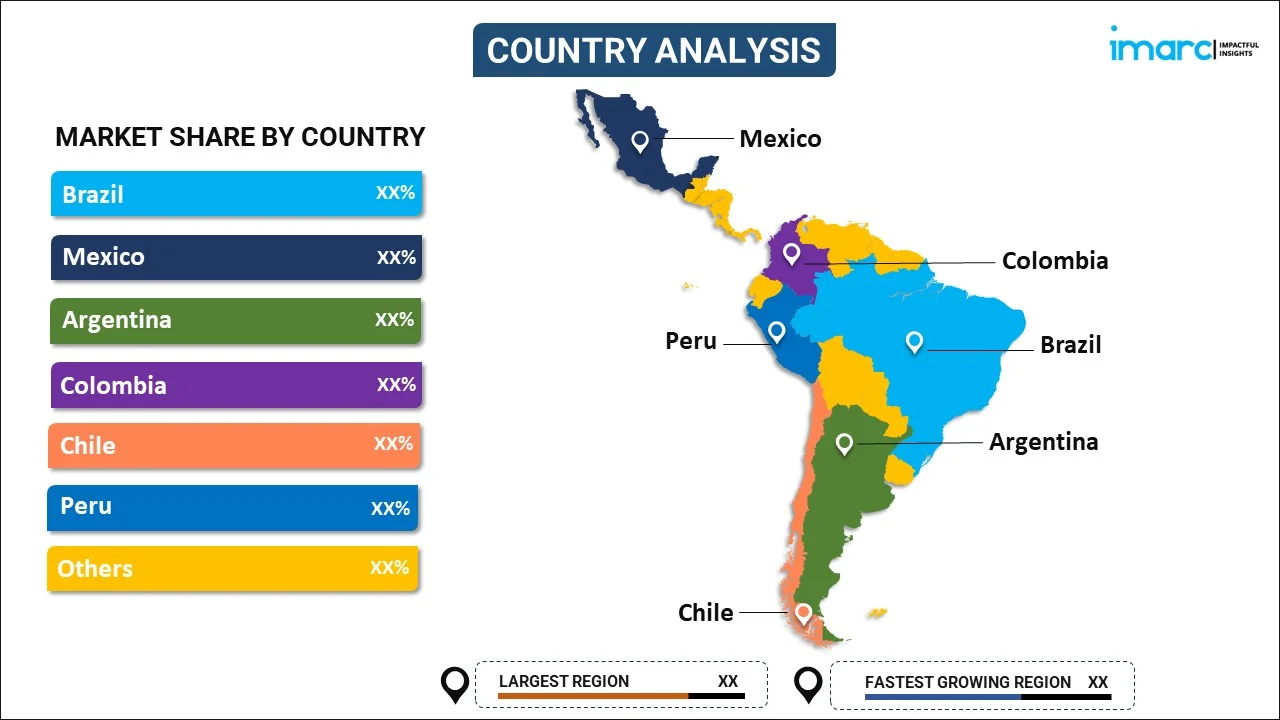
Latin America Animation Market Report by Type (2D, 3D), End Use Industry (Movies, Television, Gaming), and Country 2025-2033
Market Overview:
Latin America animation market size reached USD 27.9 Billion in 2024. Looking forward, IMARC Group expects the market to reach USD 66.1 Billion by 2033, exhibiting a growth rate (CAGR) of 9.3% during 2025-2033. The market is growing due to rising demand for 3D apps, games, and animated content across sectors. Digital platform expansion boosts reach, while countries like Argentina, Chile, Colombia, and Peru join Brazil and Mexico as emerging animation hubs, enhancing regional collaboration and global competitiveness.
|
Report Attribute
|
Key Statistics
|
|---|---|
|
Base Year
|
2024
|
|
Forecast Years
|
2025-2033
|
|
Historical Years
|
2019-2024
|
|
Market Size in 2024
|
USD 27.9 Billion |
|
Market Forecast in 2033
|
USD 66.1 Billion |
| Market Growth Rate 2025-2033 | 9.3% |
Animation is a dynamic and creative process that involves bringing images, characters, or inanimate objects to life through a sequence of frames. Utilizing various techniques, such as 2D or 3D animation, stop-motion, computer-generated imagery (CGI), etc., animators manipulate visuals to create the illusion of movement. This captivating art form is widely employed in diverse fields, including entertainment, education, marketing, and gaming. Animators also use a series of frames, each slightly different from the previous one, to produce fluid motion when played sequentially. From classic hand-drawn animations to cutting-edge digital creations, animation is a versatile medium capable of conveying narratives, emotions, and information. It serves as a powerful tool for storytelling, allowing for imaginative and visually engaging content that captivates audiences across various platforms.
Latin America Animation Market Trends:
Growing Demand for Animated Content
The Latin America animation market is experiencing a surge in demand for animated content across entertainment, education, and advertising. Streaming platforms are commissioning original animation, while broadcasters increasingly integrate animated shorts and educational series. Brands leverage animation to craft memorable ads, tapping into its ability to effectively convey complex messages and emotional narratives. Educational institutions and edtech companies use animated tutorials to improve engagement and comprehension. This cross-sector demand supports a broader content pipeline, encouraging studios to scale production and diversify offerings. As audiences—especially younger demographics—embrace animated media, content creators and distributors are capitalizing on this appetite, fostering sustainable growth in the Latin American animation sector.
Expansion of Digital Platforms
Digital platforms are crucial to the Latin America animation boom, offering unprecedented distribution reach. Streaming services, social media, and video-sharing apps have democratized content access, allowing smaller studios to reach global audiences. Platforms like Netflix, Amazon Prime, YouTube, and local OTT services are investing in regionally produced animation to capture diverse linguistic and cultural markets. Such investments inspire confidence in studios, leading to more ambitious projects. Meanwhile, algorithm-driven recommendations fuel content discovery, enhancing viewership of local animation. These platforms also provide valuable viewer analytics, enabling creators to tailor content to demographic preferences. Digital expansion thus empowers animation producers to scale, monetize, and innovate more effectively.
Rising Demand for 3D Mobile Applications and Games
The popularity of smartphones and tablets in Latin America has driven a rapid rise in demand for 3D mobile apps and games. Animation studios increasingly offer 3D character design, modeling, and animation for interactive apps, edutainment programs, and mobile gaming. As mobile gaming revenues grow, developers seek polished, immersive visuals to attract and retain users. 3D animations enhance user experience in app-based storytelling, augmented reality experiences, and educational tools. This trend supports new revenue streams for animation companies, while technology adoption, such as real-time rendering and mobile-optimized pipelines, fuels efficiency. Consequently, VFX and video games are becoming increasingly intertwined, accelerating industry development and reshaping consumer expectations.
Transmedia Storytelling
Transmedia storytelling is gaining prominence, enabling Latin American content creators to extend narratives across multiple formats. Animated characters and stories now evolve across TV series, films, webisodes, comics, and interactive apps, creating immersive ecosystems that deepen audience engagement. Producers craft story universes where animation interacts with live-action, gaming, or interactive digital media. This cohesive narrative approach maximizes content value and audience retention while driving cross-platform discovery. Studios collaborate with gaming developers, publishers, and merchandisers to monetize through books, toys, and digital experiences. As consumers expect richer content universes, transmedia strategies become essential, encouraging innovation and strategic partnerships in the Latin American animation industry.
Cultural Richness and Diversity
Latin America’s rich cultural heritage and ethnic diversity are powerful assets for the animation industry. Studios are drawing on indigenous folklore, regional myths, and local customs to create distinctive stories with universal appeal. Such authentic cultural representation resonates strongly with both domestic and international viewers seeking fresh perspectives. Governments and cultural agencies often finance culturally rooted productions, encouraging local retelling of history and heritage. This cultural richness fosters co-productions across different countries, as shared languages and cultural sensibilities foster collaboration. By embedding regional identity in animation, studios differentiate their content on the global stage and contribute to preserving intangible cultural assets through modern storytelling.
Increased Focus on Social Issues
Animation is increasingly used in Latin America to raise awareness of social issues—such as environmental conservation, gender rights, and public health. Studios produce socially conscious content, including educational series, public service animations, and documentaries in animated form. NGOs, government agencies, and international organizations fund these initiatives to effectively communicate sensitive topics, reaching wider and younger audiences. The format allows complex or emotional issues, like climate change, vaccination, and social inclusion, to be delivered in engaging, age-appropriate ways. This trend expands animation’s role beyond entertainment into meaningful societal impact, while providing creators with purpose-driven opportunities and supporting industry growth through grant-funded projects.
Cost-Effectiveness for Advertising
Businesses in Latin America increasingly use animation for advertising because it offers cost-effective branding and storytelling. Compared to live-action production, animated campaigns require smaller crews, flexible shooting conditions, and reusable assets. Brands benefit from the ability to easily localize content across languages and cultural contexts. Character-driven animated ads resonate with audiences, particularly children and young adults. Digital marketing agencies are integrating animation into multimedia campaigns, covering TV, online, and social media ads, reinforcing brand identity through vibrant visual storytelling. The lower production costs and easy adaptation capabilities encourage widespread adoption, fueling demand for animation services in the advertising sector.
Technological Advancements
Rapid technological advancements are fueling industry growth by enhancing production quality and reducing costs. Latin American studios are adopting tools like real-time engines (Unreal, Unity), optimized cloud rendering, and AI-driven workflows to accelerate 2D and 3D animation. These technologies enable faster iteration, improved visual fidelity, and remote collaboration across borders. Emerging technologies such as VR/AR and interactive storytelling platforms are also being explored creatively. Tech partnerships with global providers enable local teams to access cutting-edge solutions. The adoption of AI in animation is further revolutionizing production timelines, allowing for more efficient pre-visualization, animation generation, and voice syncing, making the regional market highly competitive globally.
Latin America Animation Market Segmentation:
IMARC Group provides an analysis of the key trends in each segment of the market, along with forecasts at the regional and country levels for 2025-2033. Our report has categorized the market based on type and end use industry.
Type Insights:

To get more information on this market, Request Sample
- 2D
- 3D
The report has provided a detailed breakup and analysis of the market based on the type. This includes 2D and 3D.
End Use Industry Insights:
- Movies
- Television
- Gaming
A detailed breakup and analysis of the market based on the end use industry have also been provided in the report. This includes movies, television, and gaming.
Country Insights:

- Brazil
- Mexico
- Argentina
- Colombia
- Chile
- Peru
- Others
The report has also provided a comprehensive analysis of all the major regional markets, which include Brazil, Mexico, Argentina, Colombia, Chile, Peru, and Others.
Competitive Landscape:
The market research report has also provided a comprehensive analysis of the competitive landscape in the market. Competitive analysis such as market structure, key player positioning, top winning strategies, competitive dashboard, and company evaluation quadrant has been covered in the report. Also, detailed profiles of all major companies have been provided.
Latin America Animation Market News:
- In July 2025, Tale Wind Studio’s 3DCG animated series Turbozaurs was launched on Prime Video across Latin America, fully dubbed in Spanish. Blending prehistoric themes with futuristic fun, the show features kids teaming up with high-tech dinosaur heroes.
- In June 2025, at Annecy-MIFA’s La Liga Focus, Latin American animation took center stage with diverse, culturally rich titles from acclaimed creators. Highlights included Chile’s Baptism, a stop-motion feature on memory and dictatorship; Mexico’s Carmín, exploring myths through mural-style animation; Brazil’s whimsical Pipa and Snail; and Hua Awakens, a Peruvian CGI tale of diaspora identity. Other standout projects tackled gender issues, fantasy, and dark comedy using 2D, 3D, and mixed media. The event showcased the region’s creative strength, unique storytelling, and international co-production potential, reinforcing Latin America’s growing influence in global animation through powerful narratives, visual innovation, and social relevance.
- In April 2024, the Latino Film Institute, in partnership with Netflix's Fund for Creative Equity, announced three fellows for the 2024 LFI Spark Animation Grant: Juan M. Abdo (Remember the Rats), Alex Avila (The Apricot), and Ana Ramírez González (Droplet). Each received $25,000 and mentorship to complete an animated short. The initiative, led by LatinX in Animation, supports emerging Latinx voices in animation. Projects explore themes of culture, identity, and resilience, furthering LFI’s mission of equity and representation in entertainment.
Latin America Animation Market Report Coverage:
| Report Features | Details |
|---|---|
| Base Year of the Analysis | 2024 |
| Historical Period | 2019-2024 |
| Forecast Period | 2025-2033 |
| Units | Billion USD |
| Scope of the Report | Exploration of Historical Trends and Market Outlook, Industry Catalysts and Challenges, Segment-Wise Historical and Future Market Assessment:
|
| Types Covered | 2D, 3D |
| End Use Industries Covered | Movies, Television, Gaming |
| Countries Covered | Brazil, Mexico, Argentina, Colombia, Chile, Peru, Others |
| Customization Scope | 10% Free Customization |
| Post-Sale Analyst Support | 10-12 Weeks |
| Delivery Format | PDF and Excel through Email (We can also provide the editable version of the report in PPT/Word format on special request) |
Key Benefits for Stakeholders:
- IMARC’s industry report offers a comprehensive quantitative analysis of various market segments, historical and current market trends, market forecasts, and dynamics of the Latin America animation market from 2019-2033.
- The research report provides the latest information on the market drivers, challenges, and opportunities in the Latin America animation market.
- Porter's five forces analysis assist stakeholders in assessing the impact of new entrants, competitive rivalry, supplier power, buyer power, and the threat of substitution. It helps stakeholders to analyze the level of competition within the Latin America animation industry and its attractiveness.
- Competitive landscape allows stakeholders to understand their competitive environment and provides an insight into the current positions of key players in the market.
Key Questions Answered in This Report
The Latin America animation market size reached USD 27.9 Billion in 2024.
The Latin America animation market is expected to reach USD 66.1 Billion by 2033, exhibiting a CAGR of 9.3% during 2025-2033.
Market growth is driven by rising demand for digital content across streaming platforms, increased investments in local animated productions, expanding gaming and advertising sectors, and growing consumption of animation in education and entertainment among youth audiences.
Need more help?
- Speak to our experienced analysts for insights on the current market scenarios.
- Include additional segments and countries to customize the report as per your requirement.
- Gain an unparalleled competitive advantage in your domain by understanding how to utilize the report and positively impacting your operations and revenue.
- For further assistance, please connect with our analysts.
 Request Customization
Request Customization
 Speak to an Analyst
Speak to an Analyst
 Request Brochure
Request Brochure
 Inquire Before Buying
Inquire Before Buying




.webp)




.webp)












